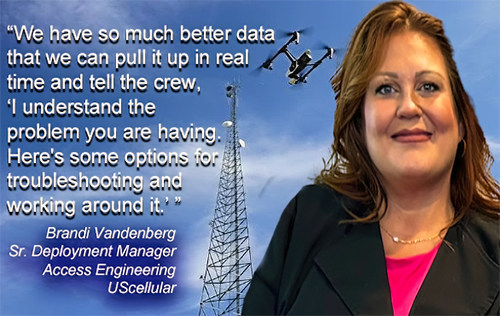Better data, better quality:
How drones are revolutionizing US Cellular’s tower maintenance
By J. Sharpe Smith, Contributing Editor
According to a speaker at a recent NATE conference, data provided by drones is helping carriers increase their
quality control, and tower maintenance companies are getting a report card judging their work on the tower.
 “I’m a data person. I like to measure things, and we’ve had an amazing experience with drones,” said Brandi Vandenberg, Sr. Deployment Manager – Access Engineering at US Cellular during the session, Doing More
“I’m a data person. I like to measure things, and we’ve had an amazing experience with drones,” said Brandi Vandenberg, Sr. Deployment Manager – Access Engineering at US Cellular during the session, Doing More
with Less – The New Normal, during the NATE Emerging Technologies Expo, held Sept. 25, in Valley, Neb.
“We had to make sure that we’re getting that data, and we got remarkable data coming back from our vendor
partner with the drone inspections.”
US Cellular used to send climbers to inspect 35 percent of its 5G overlay deployments to ensure the quality of the implementation. As the COVID pandemic gripped the nation in 2019, Vandenberg decided that the carrier needed
to automate that process. Today, with drones, the carrier inspects all of its installations while reducing the costs
of tower climbs.
US Cellular compares the results of the drone inspections with the tower crews’ closeout packages. Using a scoring system, the carrier grades the tower crews’ work and sends them the results. This can be used to weed out subpar
companies. On a more positive note, the report cards have created a sense of pride among the contractors, who have
implemented bonus programs for climbers based on the scores that they get back.
“The higher the quality of the install, the less time is spent sending crews back to fix the work,” Vandenberg said.
“From an operator perspective, it has driven a higher quality in our maintenance, reducing our maintenance costs and our outages.”
The accumulated data obtained from drone flights can be used by the carrier to help a crew that calls in with a problem at a site.
“We have so much better data that we can pull it up in real-time and tell the crew, ‘I understand the problem you are having.
Here’s some options for troubleshooting and working around it,’” Vandenberg said.